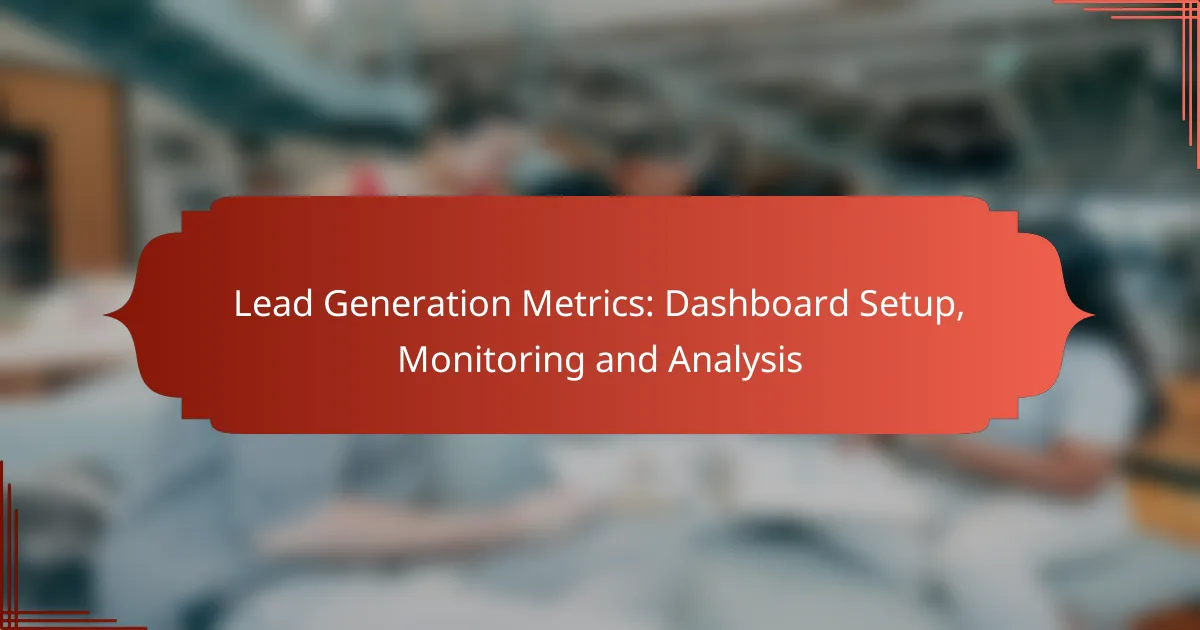Effective lead generation is crucial for business growth, and monitoring key metrics is essential for optimizing your strategies. By setting up a comprehensive dashboard that tracks conversion rates, cost per lead, and lead quality, you can gain valuable insights into your marketing efforts. Implementing best practices for data analysis will enable you to make informed decisions and enhance your overall lead generation performance.

What are the key lead generation metrics to monitor?
Key lead generation metrics to monitor include conversion rate, cost per lead, lead quality score, lead source performance, and sales qualified leads. These metrics provide valuable insights into the effectiveness of your lead generation efforts and help optimize your marketing strategies.
Conversion Rate
Conversion rate measures the percentage of leads that take a desired action, such as making a purchase or signing up for a newsletter. To calculate this, divide the number of conversions by the total number of leads and multiply by 100. A higher conversion rate indicates more effective lead generation tactics.
Consider setting benchmarks based on your industry; for many sectors, conversion rates typically range from 1% to 5%. Regularly analyze this metric to identify trends and adjust your strategies accordingly.
Cost Per Lead
Cost per lead (CPL) is the total cost incurred to acquire a single lead. To calculate CPL, divide your total marketing expenses by the number of leads generated during that period. Understanding CPL helps in budgeting and assessing the efficiency of your marketing campaigns.
A reasonable CPL varies by industry; for example, B2B companies might see CPLs in the range of $50 to $200, while B2C companies may have lower costs. Keep an eye on this metric to ensure your lead generation efforts remain cost-effective.
Lead Quality Score
Lead quality score evaluates the potential of a lead to convert into a customer based on predefined criteria, such as demographics and engagement level. Assign scores based on factors like job title, company size, and interaction with your content. This helps prioritize leads for follow-up.
Implement a scoring system that aligns with your sales process to ensure consistency. Regularly review and adjust your criteria to reflect changes in your target market or business goals.
Lead Source Performance
Lead source performance tracks the effectiveness of different channels in generating leads. By analyzing which sources yield the highest quality leads or conversions, you can allocate resources more effectively. Common sources include social media, email marketing, and paid advertising.
Utilize tracking tools to monitor performance across channels. This allows you to identify high-performing sources and invest more in those areas while optimizing or eliminating underperforming ones.
Sales Qualified Leads
Sales qualified leads (SQLs) are leads that have been vetted and deemed ready for direct sales engagement. This metric is crucial as it indicates the quality of leads that have progressed through your sales funnel. Establish clear criteria for what constitutes an SQL based on your sales process.
Regularly review your SQL conversion rates to ensure your lead nurturing processes are effective. Aim to maintain a healthy ratio of SQLs to total leads, which can vary widely but should ideally be above 20% for many businesses.

How to set up a lead generation dashboard?
Setting up a lead generation dashboard involves selecting appropriate tools, defining key performance indicators (KPIs), and integrating various data sources. This process allows businesses to effectively track and analyze their lead generation efforts in real-time.
Selecting the right tools
Choosing the right tools is crucial for an effective lead generation dashboard. Popular options include CRM systems like Salesforce, marketing automation platforms such as HubSpot, and analytics tools like Google Analytics. Each tool offers different features, so consider your specific needs and budget when making a selection.
Look for tools that can easily integrate with each other to streamline data flow. For instance, a CRM that connects with your email marketing software can provide a comprehensive view of your lead generation activities.
Defining key performance indicators
Key performance indicators (KPIs) are essential for measuring the success of your lead generation efforts. Common KPIs include the number of leads generated, conversion rates, and cost per lead. Establishing these metrics helps you assess the effectiveness of your strategies.
When defining KPIs, ensure they align with your business goals. For example, if your aim is to increase sales, focus on metrics that directly impact revenue, such as the lead-to-customer conversion rate.
Integrating data sources
Integrating data sources is vital for a holistic view of your lead generation performance. This involves connecting your CRM, marketing automation tools, and web analytics platforms to gather data in one place. This integration allows for more accurate reporting and analysis.
Consider using APIs or integration platforms like Zapier to automate data transfers between systems. This reduces manual entry errors and ensures that your dashboard reflects the most current information available.

What are best practices for monitoring lead generation metrics?
Best practices for monitoring lead generation metrics involve establishing a systematic approach to track performance, analyze data, and make informed decisions. Regular reviews and the use of appropriate tools can enhance the effectiveness of your lead generation efforts.
Regular reporting schedule
Setting a regular reporting schedule is crucial for effective monitoring of lead generation metrics. Weekly or monthly reports can help identify trends and assess the performance of various campaigns over time. Consistency in reporting allows for timely adjustments and strategic planning.
When creating reports, focus on key performance indicators (KPIs) such as conversion rates, cost per lead, and lead qualification rates. This targeted approach ensures that you are measuring the most relevant metrics for your business goals.
Real-time data tracking
Implementing real-time data tracking enables immediate insights into lead generation performance. Utilizing tools that provide live updates allows teams to react quickly to changes in lead quality or volume. This can be particularly beneficial during high-traffic periods or promotional campaigns.
Consider integrating CRM systems or marketing automation platforms that offer real-time analytics. These systems can help identify which channels are performing best, allowing for rapid optimization of marketing strategies.
Utilizing visualization tools
Visualization tools can significantly enhance the understanding of lead generation metrics by presenting data in an easily digestible format. Dashboards that display graphs, charts, and heat maps can help stakeholders quickly grasp performance trends and anomalies.
When selecting visualization tools, look for those that allow customization to focus on your specific KPIs. Tools like Tableau or Google Data Studio can be effective for creating dynamic reports that facilitate better decision-making.

How to analyze lead generation data effectively?
Analyzing lead generation data effectively involves tracking key metrics, identifying patterns, and making data-driven decisions. By focusing on trends, segmenting leads, and benchmarking against industry standards, businesses can optimize their lead generation strategies for better results.
Identifying trends
Identifying trends in lead generation data helps businesses understand the effectiveness of their marketing efforts over time. Look for patterns in metrics such as conversion rates, lead sources, and engagement levels. For instance, if a particular campaign consistently yields higher conversion rates, it may indicate a successful approach worth replicating.
Utilize data visualization tools to create graphs and charts that highlight these trends. Regularly reviewing this visual data can reveal seasonal fluctuations or shifts in consumer behavior, allowing for timely adjustments to marketing strategies.
Segmenting leads
Segmenting leads involves categorizing them based on specific criteria such as demographics, behavior, or source. This practice enables targeted marketing efforts and personalized communication, which can significantly enhance engagement and conversion rates. For example, leads from social media may respond differently than those from email campaigns.
Consider using a Customer Relationship Management (CRM) system to efficiently manage and analyze segmented data. By tailoring your approach to each segment, you can improve the relevance of your messaging and increase the likelihood of conversion.
Benchmarking against industry standards
Benchmarking against industry standards allows businesses to assess their lead generation performance relative to competitors. Understanding average conversion rates, lead costs, and customer acquisition costs in your industry can provide valuable insights into your own metrics. For example, if the industry average conversion rate is around 5%, and your rate is significantly lower, it may indicate areas for improvement.
Research industry reports and studies to gather relevant benchmarks. Regularly comparing your metrics against these standards can help you identify gaps and set realistic performance goals, ensuring that your lead generation efforts remain competitive.

What tools can enhance lead generation analysis?
Several tools can significantly improve lead generation analysis by providing insights into customer behavior and campaign effectiveness. Utilizing these tools allows businesses to track metrics, optimize strategies, and ultimately increase conversion rates.
HubSpot CRM
HubSpot CRM is a comprehensive platform that offers tools for managing customer relationships and tracking lead interactions. It provides detailed analytics on lead sources, engagement levels, and conversion rates, which can help businesses refine their marketing efforts.
Key features include customizable dashboards, automated reporting, and integration with various marketing tools. Businesses should leverage these features to monitor lead performance and identify areas for improvement.
Google Analytics
Google Analytics is a powerful tool for tracking website traffic and user behavior, making it essential for lead generation analysis. It allows businesses to see how visitors interact with their site, which pages generate the most leads, and where users drop off in the conversion funnel.
To maximize its effectiveness, set up goals and conversion tracking to measure specific actions, such as form submissions or downloads. Regularly reviewing these metrics can help businesses adjust their strategies to enhance lead generation efforts.
Salesforce
Salesforce is a leading customer relationship management (CRM) platform that provides robust tools for lead tracking and analysis. It offers detailed reporting capabilities, allowing businesses to analyze lead data across various stages of the sales funnel.
Utilizing Salesforce’s lead scoring and nurturing features can help prioritize high-quality leads and streamline follow-up processes. Companies should ensure their teams are trained to use these tools effectively to maximize their lead generation potential.

What are common pitfalls in lead generation metrics analysis?
Common pitfalls in lead generation metrics analysis include overlooking data quality, misinterpreting metrics, and failing to align metrics with business goals. These mistakes can lead to misguided strategies and wasted resources.
Ignoring data quality
Data quality is crucial for accurate lead generation metrics analysis. Poor data can stem from inaccurate entries, outdated information, or inconsistent formats, leading to misleading conclusions about lead performance.
To ensure high data quality, regularly clean and validate your data sources. Implement automated checks to identify duplicates or errors, and establish clear guidelines for data entry to maintain consistency.
For example, if your lead database includes outdated contact information, you may waste time and resources targeting leads that are no longer viable. Aim for a data accuracy rate of at least 90% to enhance your analysis and decision-making.
